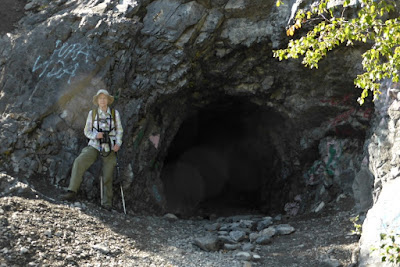There's still a lot of manual labor in the construction biz.
Hertz was running low on cars in Calgary and upgraded us to a Sonata. On arriving at Canadian Artisans Bed & Breakfast in Canmore we were shocked to see the empty lot across the gravel drive fenced off and dug up.
Val and Bob told us that the vacant lot had changed hands three times in the last fifteen years, but they had been given only two weeks notice that construction was to begin. Every tree was removed and the building will stretch to the minimum 5' setback from the property line. Ouch! What a crowding.
The next day was a Thursday, and the Canmore farmers market.
Love this sign.
We bought some luscious fruit -- fresh berries from British Columbia -- and, from a German-style bakery, lunch sandwiches. After gearing up we drove a short distance east for today's warm-up hike, sections of the West Wind Creek Loop. Parts of today's hike were repeats from last year, and some new.
The start has several creek crossings.
After a while the trail took a right turn and began to climb the ridge, but a lesser path split off shortly after the turn, taking us into new territory. More winding through the cool woods ensued, and then the land began to open up.
 |
| The ridge trail goes up to those green and beige peaks. |
At the end we even bushwhacked up the ridge for a few minutes along a sketchy route before thinking the better of it and returning to the meadow. Then it was time for the first half of lunch in a grove of trees.
We backtracked to the ridge trail and decided to climb as far as the first good view. The vista revealed the difference between the (relatively) low ridge we were ascending and the high mountains.
After the second half of lunch at this viewpoint we descended and returned to the car, happy with our exploration.
The next day, Sept. 6th, our goal to was to reach the Chockstone on McGillivray Creek, which had eluded us last year. We parked closer to the trailhead, and found the path that departs from the Trans-Canada Trail (renamed the Great Trail in 2016).
The trail remained in the woods above McGillivray Creek, whose stream bed is expanded and strewn with rock and other debris from the flood of 2013.
Many of the fallen trees that last year had created obstacles in our path were now cut in two parts, perhaps by the Lac Des Arcs Climbing School, which uses the creek walls for climbing exercises.
 |
| Rings on the rock wall. |
The valley narrowed and the path, also shrinking, climbed more and more steeply to stay above the creek, demanding constant vigilance of pole and foot placement, rock steps, and roots. It leveled out -- on average -- and after a while corkscrewed down towards the channel bottom.
Large rocks were omnipresent, and grew huge as we ascended along the streambed: the heavy boulders dropped out of the flood first, smaller ones downstream.
Our steps forward became trickier and time-consuming; we wove from side to side to find a way forward, sometimes climbing up a scrap of bankside, always placing our feet and hands carefully. Wet rocks were treacherous and best avoided. After half an hour of this we reached the Chockstone.
 |
| Really, Joan, it's quite safe ... |
We decided this was far enough. Back at the parking area we met the first other hikers of the day, just starting out. Late starts seem not uncommon in Canada.
The 7th was a transition day. Joan and I were heading for Cathedral Mountain Lodge, a comfortable accommodation only a short drive away from the Lake O'Hara parking area, making it easy to catch the O'Hara morning bus. We picked up lunches at Storm Mountain Lodge, directly on our way to Boom Lake, today's hike. We were also checking out Storm Mountain as a place to stay next year.
Ready for a sunny Saturday excursion, we arrived at the parking area for Boom Lake, our first time.
The trail is wide and after an initial climb rather gentle.
Boom Lake is a family favorite because of the easy hiking. The last few hundred meters are rocky and uneven, but the stretch through the forest had no obstacles other than an occasional muddy patch or footbridge.
This panoramic shot of the lake suffers from prismatic stutters, because of the angle of the sun, but it's the best I have.
A couple dozen people -- mostly women -- had spread out along the rocky shore, boulder hopping to find a conducive sit-spot. Looking up the lake,
the ramparts are impressive. Joan and I found our own spot and had lunch. We heard a pika making its "eep!" call, and a bold chipmunk sniffed and nuzzled Joan's pant leg.
Shortly after leaving the lake we encountered an arriving Japanese family of four; a young boy struggled with a cart/wagon carrying various picnic supplies, including a pillow. It seemed quite incongruous. On the way back we met many inbound groups of two to six, usually with a dog or two, which ranged from small lapdogs to a mastiff -- all on leash, as they should be in the park. When we reached our car there were only one or two parking spaces left.
We had a good dinner and rest at Cathedral Mountain, although I managed to knock my clock/meditation-timer off the bedside table onto the floor. The electronics still worked but the LCD display was a cracked and unintelligible inkblot. And the darn thing isn't made any more. I had to improvise with my phone.
Well, tomorrow would mean Lake O'Hara, which can soothe many wounds.
















































